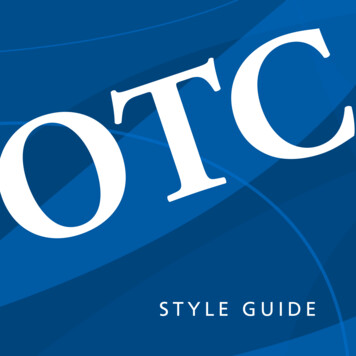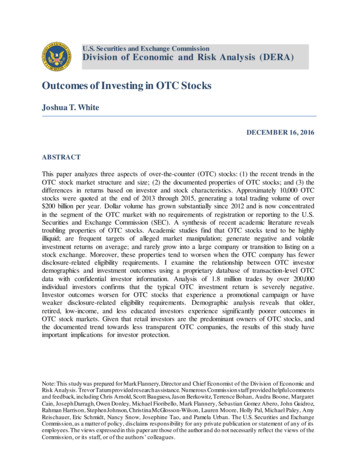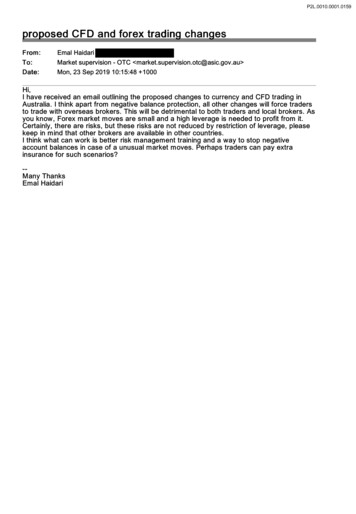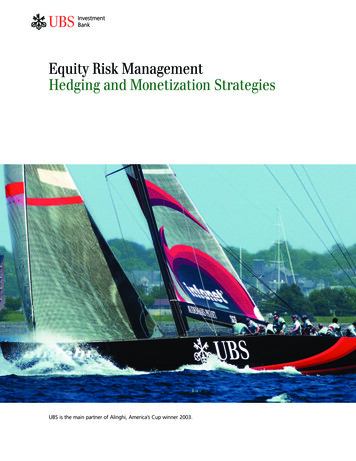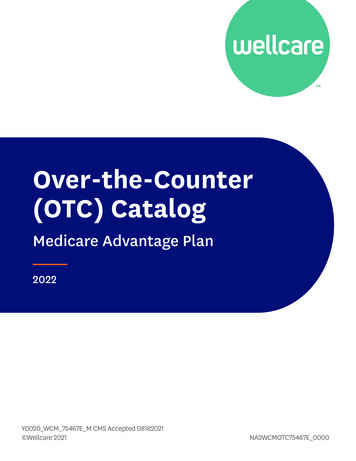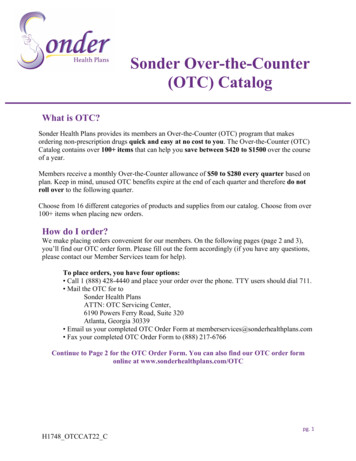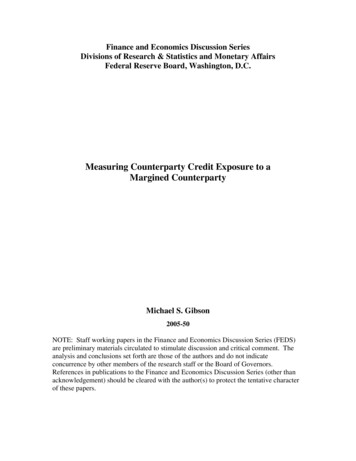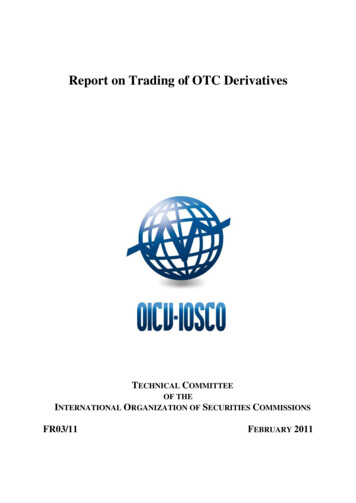
Transcription
Report on Trading of OTC DerivativesTECHNICAL COMMITTEEOF THEINTERNATIONAL ORGANIZATION OF SECURITIES COMMISSIONSFR03/11FEBRUARY 2011
ForewordIn September 2009, the G-20 Leaders stated that all standardised over-the-counter (OTC)derivatives contracts should be traded on exchanges or electronic trading platforms, whereappropriate, and cleared through central counterparties by the end of 2012 in order toimprove transparency, mitigate systemic risk, and protect against market abuse in thederivatives markets.1 To support the realisation of these objectives, a working group led byrepresentatives of the Committee on Payment and Settlement Systems (CPSS), theInternational Organization of Securities Commissions (IOSCO), and the EuropeanCommission (OTC Derivatives Working Group) was formed to set out policy optionssupporting the consistent implementation of appropriate measures regarding trading, clearing,and reporting across jurisdictions. The Financial Stability Board (FSB) adopted the report ofthe OTC Derivatives Working Group and submitted the report to the G-20 Finance Ministersand Central Bank Governors in October 2010 (FSB Report)2. The FSB Report presentstwenty-one recommendations addressing the implementation of the G-20 commitments.In October 2010, IOSCO formed the Task Force on OTC Derivatives Regulation (TaskForce), in part to address the recommendation in the FSB Report that IOSCO conduct a studyevaluating the benefits and challenges associated with the implementation of measures aimedat increasing exchange and electronic trading of OTC derivative products.This report (Report on Trading) presents the Task Force‟s analysis of the characteristics ofexchanges and electronic platforms, the characteristics of OTC derivatives products relevantto exchange or electronic platform trading, the costs and benefits associated with exchange orelectronic platform trading of OTC derivatives relative to the stated goals of the G-20Leaders‟ commitment, including identification of benefits that are incremental to thoseprovided by increased standardisation, central clearing, and reporting to trade repositories,and methods of increasing the use of exchanges or electronic platforms for trading in thederivatives markets.The Co-Chairs are grateful to the Task Force‟s members and observers for their hard workand dedication in preparing this Report on Trading.1Statement No. 13, Leaders’ Statement: The Pittsburgh Summit (September 24 – 25, 2009), availableat http://www.g20.org/ Documents/pittsburgh summit leaders statement 250909.pdf2Implementing OTC Derivatives Market Reform, Financial Stability Board, 25 October 2010 available ons/r 101025.pdf.2
ContentsChapter1PageIntroduction4Background Information6Characteristics of Organised Platforms That Could Be Used forDerivatives Trading10A. Introduction – Trading PlatformsB. The Concept of Organised Platform TradingC. Approaches Taken in Different Jurisdictions234Characteristics of OTC Derivatives Products Relevant to OrganisedPlatform TradingA. StandardisationB. Market LiquidityC. Characteristics of Various Platforms22Benefits and Costs of Increasing Organised Platform Trading, IncludingThose That Are Incremental to Standardisation, Central Clearing, andReporting to Trade RepositoriesA. Benefits and Costs of Increasing Organised Platform TradingB. Benefits and Costs that are Incremental to Standardisation, CentralClearing, and Reporting to Trade Repositories33Regulatory Actions That May be Advisable in order to Transition OTCDerivatives Trading onto Organised Platforms and Conditions ThatWarrant Taking Such Actions44A.B.C.D.5101113Encourage and Establish Targets for Market IncentivesRegulatory IncentivesRegulatory MandatesMinimising Regulatory Arbitrage222529334044454647Conclusion48Appendix A: Trading Platforms51Appendix B: List of Task Force Members533
IntroductionAs of December 2009, approximately 89% of derivatives contracts were transacted over-thecounter (OTC).3 That is, they were transacted directly between two contracting partieswithout the interposing of an exchange or other intermediary. While the number ofderivatives contracts that are traded on exchanges or other electronic platforms (hereinafterreferred to as “organised platform(s)”) has grown throughout 2009 and 2010, 4 the OTCportion of the market continues to dominate. This dominance mainly is attributed to suchcontracts‟ customised nature, which allows them to meet the specific needs of thecounterparties. 5The recent financial crisis revealed certain deficiencies in the OTC derivatives markets. Tohelp address these deficiencies, the G-20 Leaders in September 2009 stated that “[a]llstandardised OTC derivatives contracts should be traded on exchanges or electronic tradingplatforms, where appropriate, and cleared through central counterparties by end-2012 at thelatest” in order to improve transparency, mitigate systemic risk, and protect against marketabuse in the derivatives markets.6 Building on this commitment, in June 2010, the G-20Leaders agreed to work in a coordinated manner to accelerate the implementation of OTCderivatives regulation and supervision and to increase market transparency and productstandardisation.7To support the implementation of the G-20 Leaders‟ commitments, a working group led byrepresentatives of the Committee on Payment and Settlement Systems (CPSS), theInternational Organization of Securities Commissions (IOSCO), and the EuropeanCommission (OTC Derivatives Working Group) was formed to set out policy optionssupporting the consistent implementation of the G-20 commitments across jurisdictions. TheOTC Derivatives Working Group produced a report which sets forth twenty-onerecommendations addressing the practical issues that authorities may encounter inimplementing the G-20 Leaders‟ commitments concerning standardisation, central clearing,organised platform trading, and the reporting of OTC derivatives to trade repositories. TheFinancial Stability Board adopted the OTC Derivatives Working Group report and submittedit to the G-20 Finance Ministers and Central Bank Governors in October 2010 (FSB Report).In an effort to address the G-20 commitment that all standardised derivatives contracts shouldbe traded on organised platforms, where appropriate, the FSB Report recommended thatIOSCO, with the involvement of appropriate authorities, conduct an analysis of the benefitsand costs associated with increasing organised platform trading of derivatives. This report3This figure reflects notional amounts outstanding of derivatives contracts. Bank of InternationalSettlements, BIS Quarterly Review September 2010 – International banking and financial marketdevelopments, A121, available at http://www.bis.org/publ/qtrpdf/r qt1009.pdf.4Id.5Deutsche Börse Group, The Global Derivatives Market: A Blueprint for Market Safety and Integrity, 9(2009), available blications/WPDerivativesMarketBlueprint.pdf.6Id Note 1.7Declaration No. 25, The G-20 Toronto Summit Declaration (June 26 – 27, 2010), available athttp://www.g20.org/ Documents/g20 declaration en.pdf.4
(Report on Trading) aims to undertake such analysis, with the goal of providing regulatorsacross jurisdictions an analytical tool that can inform their current and future efforts toaddress the trading of derivatives on organised platforms.The Report on Trading is organised as follows. The chapter entitled “BackgroundInformation” describes the current state of derivatives markets in various jurisdictions,including the OTC and organised platform traded portions of such markets and, wherepossible, the transactional volumes attributable to each. Chapter 1 sets forth thecharacteristics of organised platforms that could be used for derivatives trading. Chapter 2discusses the characteristics of OTC derivatives products that make organised platformtrading of derivatives practicable, including standardisation and liquidity considerations.Chapter 3 addresses the benefits and costs associated with increasing organised platformtrading with respect to the G-20 Leaders‟ stated objectives of improving transparency,mitigating systemic risk, and protecting against market abuse in the OTC derivatives markets,including identification of benefits that are incremental to those provided by increasedstandardisation, central clearing, and reporting to trade repositories. Chapter 4 explorespossible regulatory incentives and mandates that could be used to increase the movement ofOTC derivatives trading to organised platforms and considers the conditions that may warrantthe use of such incentives and mandates. Lastly, the findings of the Task Force are presentedin the Conclusion.5
Background InformationOverall market informationThere are a number of ways to measure the size of the exchange-traded and OTC derivativesmarkets, including by turnover, notional outstanding and number of contracts. Whenmeasured by either notional turnover or notional outstanding, interest rate derivatives are thelargest category – representing approximately three-quarters of total derivatives notionaloutstanding and traded. This means that changes in the total notional size of the derivativesmarkets will be largely shaped by the amount of trading in interest rate derivatives.Care should be taken in considering the absolute sizes and in comparing the sizes of differenttypes of derivatives markets. Given the different assets underlying derivative products, thenotional sizes of derivative products, the total size of derivatives outstanding, or volumetraded may not fully represent the size, liquidity or risk in a particular derivatives market. Toillustrate the features of the different markets, we have used a number of different measuresin an attempt to demonstrate the absolute and respective sizes of the markets. However, nosingle measure will be perfect across all markets, but the following should provide a generalidea of how the different derivatives markets compare.The Bank for International Settlements (BIS) has estimated that the turnover across globalexchange traded futures and options was 554.6 trillion in 2nd Quarter 2010. 8 It is estimatedthat 86.5% of this turnover was interest rate derivatives, 11.5% was equity index derivativesand 2.1% was foreign exchange derivatives.BIS also has estimated that the total OTC derivatives outstanding as of June 2010 was 583trillion, of which 77.5% was interest rate derivatives, 9.1% was foreign exchange derivatives,5.2% credit derivatives, 1.1% equity derivatives, 0.5% commodity derivatives and 6.6% wasother or unknown. 9 This represents a more than doubling in notional outstanding from fiveyears earlier, with the split between product classes being largely similar 10.BIS has estimated that the daily turnover of global OTC interest rate derivatives was 2.08trillion in April 2010, while the daily turnover of exchange traded interest rate derivativeswas 8.14 trillion. 11 Between April 2007 and April 2010, BIS found that trading activity inOTC interest rate derivatives had grown by 24%, which was slower than the 64% growth rate8Bank for International Settlements, BIS Quarterly Review September 2010 – International banking andfinancial market developments, A126, available at http://www.bis.org/publ/qtrpdf/r qt1009.pdf.9Bank for International Settlements, BIS Quarterly Review December 2010 – International banking andfinancial market developments, A121, available at 0As of June 2005, the total notional OTC derivatives outstanding was 283 trillion, of which 72.5% wasinterest rate derivatives, 11.0% was foreign exchange contracts, 3.6% was credit default swaps, 1.6%was equity-linked contracts, 1.0% was commodity contracts and 10.3 was unallocated. See Bank forInternational Settlements, Semiannual OTC derivatives statistics at end-June 2010, Table 19, availableat http://www.bis.org/statistics/derstats.htm11Bank for International Settlements, Triennial Central Bank Survey of Foreign Exchange andDerivatives Market Activity in April 2010 – Preliminary results (September 2010), Table 6 – GlobalOTC interest rate derivatives market turnover by instrument at 12, available athttp://www.bis.org/publ/rpfx10.pdf.6
between 2004 and 2007.12By location for the 2 nd quarter of 2010, BIS found that 50.8% of the total turnover inorganised platform traded derivatives took place on North American markets, 42.4% inEurope, 4.0% in the Asia-Pacific region, and 2.9% elsewhere. 13Trading frequency and market participantsWhile both organised platform-traded and OTC-traded derivatives trade far less often thancash products, derivatives that are traded on organised platforms tend to be more liquid thanderivatives that are traded OTC.The International Swaps and Derivatives Association (ISDA) and others have stated thatthere are less than 2,000 standardised interest rate swaps executed globally on an averageday. 14 The most liquid swaps (10-year dollar interest rate swaps) trade about 200 times perday, while most swaps trade less than 20 times per day. 15 In the credit default swap (CDS)market, ISDA notes that the most liquid reference entities (all of which were sovereignentities) averaged 20 trades per day, while the average trade size is around US 5 million forsingle name CDS.16ISDA has undertaken additional research in which it found that 94% of Fortune 500companies use derivatives, with 88% of such companies using currency derivatives and 83%using interest rate derivatives.17 Other types of derivatives products are used less often bysuch companies.18BIS has reported data on the types of market participants across each product class ofderivatives. Using BIS data, the table below shows the share of outstanding exposure fordifferent categories of market participants in each class of OTC derivatives as at June 2010. 1912Id. at 5-6.13Bank for International Settlements, BIS Quarterly Review September 2010 – International banking andfinancial market developments, A126, available at http://www.bis.org/publ/qtrpdf/r qt1009.pdf.14Int‟l Swaps & Derivatives Ass‟n et al., Input into the work of the IOSCO Task Force on OTCDerivatives Regulation: Exchange and Electronic Trading (“ISDA Memo”) 4 (December 2010) (onfile with the IOSCO General Secretariat). The ISDA Memo notes that derivatives productstandardisation has three primary elements: (1) legal uniformity, such as standard transactiondocumentation and definitions; (2) process uniformity and automation; and (3) product uniformity,such as standard valuation, payment structures and dates. The concept of standardisation is discussedin more detail in Section II herein.15Id.16Id. (citing to Depository Trust & Clearing Corporation data). This average number of trades was overthe period 21 December 2009 to 20 June 2010.17ISDA Research Notes, Number 2 2009, 2009 ISDA Derivatives Usage Survey.18Forty-eight percent of Fortune 500 companies use commodity derivatives, 29% use equity derivativesand 20% use credit derivatives. See id.19See Bank for International Settlements, BIS Quarterly Review December 2010 – International bankingand financial market developments, A121, available at http://www.bis.org/statistics/otcder/dt1920a.pdf.7
Table I: Notional amounts outstanding by type of market participant for OTCderivatives product classes as of June 2010.Foreignexchangederivatives41.0%Reporting 7%58.7%41.2%35.2%8.2%11.2%2.8%Interest rate EquityderivativesderivativesMarket information by platform typeEstimates for the proportion of turnover traded on bilateral versus multilateral platforms areshown in Table II, while the proportion of trading taking place by voice versus electronicallyis shown in Table III.Table II: Estimated monthly turnover by type of trading platform for OTCderivatives product classes as of June 2010. 22Interest rate derivativesCredit derivativesEquity derivativesBilateral ExecutionMultilateral platforms68.9%62.6%82.9%31.1%37.4%17.1%Table III: Estimated monthly turnover by method of execution for all venues(bilateral and multilateral) for OTC derivatives product classes as of June2010.232010.2% of credit default swaps outstanding are to CCPs and are not reflected in this table.21BIS defines “reporting dealers” as those dealers that provide data to their respective central banks.This data is then used by BIS in compiling their quarterly reviews. These reporting dealers report theirtrading with the different categories of counterparties. See BIS Guide to the international financialstatistics, .22These estimates are based on supervisory data provided to certain members of the Task Force.Bilateral execution includes by phone, email, bilateral messaging platforms, and platforms sponsoredby a single market maker and available to one or more counterparties for trade execution. Multilateralplatforms include platforms that contain multiple market-maker bids and offers and include multilateraltrading facilities, “click to trade” screens and request for quote platforms.23These estimates are based on supervisory data provided to certain members of the Task Force. Voiceexecution includes by phone, email or similar bilateral messaging platforms. Electronic executionincludes platforms that are sponsored by a single market maker and available to one or morecounterparties for trade execution, or multilateral electronic platforms.8
Interest rate derivativesCredit derivativesEquity derivativesVoice ExecutionElectronic Execution87.7%83.3%85.7%12.3%16.7%14.3%These data indicate that OTC derivatives are predominantly traded bilaterally, with voiceexecution (which includes email and other bilateral forms of messaging) dominating overelectronic platform trading. Credit derivatives appear to make the greatest use of multilateralplatforms, as well as the greatest use of electronic execution methods. 24. By contrast, equityderivatives are traded primarily via bilateral and voice execution methods.24This might be explained by the increased use of standard coupons, payments dates and terms for creditderivatives, which generally better support the use of electronic and multilateral platforms forexecution.9
Chapter 1 Characteristics of Organised Platforms That Could be Used forDerivatives TradingIntroduction – Trading PlatformsA.In general terms, a trading platform is a system or facility that brings together buying andselling interests in one or more financial instruments, leading to the execution of transactionsin those instruments. A variety of functionalities can be employed to bring together suchtrading interests, and the principal systems currently in operation include the following: An order book system. In its most basic form, an order book is a system or platformin which its market participants can enter multiple bids and offers, observe bids andoffers entered by other market participants, and choose to transact on such bids andoffers. Such systems can incorporate pre-determined criteria governing theprioritisation of, and interactions between, buy and sell orders, such as to provide atransparent and objective basis for the continuous or periodic execution oftransactions. For example, in a limit order book (LOB) system, orders are typicallyprioritised for execution based on the competitiveness of the bid/offer price of theorder, followed by the time of submission and such systems generally support a rangeof order types to facilitate the execution of transactions in different ways. Such ordertypes will include limit orders, which enable a participant to specify the highest priceat which it is prepared to buy, or the lowest price at which it is prepared to sell, agiven quantity of financial instruments and which provide the pre-trade transparencyinformation within the system. Other order types enable participants to access ordersresiding in the order book to increase the speed or certainty of execution, such asimmediate or cancel orders. Order book systems are typically fully automated. A market maker system. A market maker system is based on the presence of one ormore liquidity providers who are willing to deal on a regular or continuous basisagainst their proprietary capital by providing quotes to buy and sell financialinstruments which are accessible to other participants in the system. Such systemscan be organised on the basis of a single dealer, which acts as counterparty to eachtrade, or on the basis of multiple dealers that compete for participant business. Theterms on which market maker(s) are prepared to trade can be communicated indifferent ways, such as through request for stream (RFS) systems which representfirm commitments to buy and sell, or through request for quote (RFQ) systems wherea price is provided by a market maker in response to a request submitted by aparticipant. These systems can be fully automated or fully manually operated, or cancombine both approaches (see the discussion of hybrid systems below). A periodic auction system. A periodic auction system generally is based on theexecution of orders in batches at set intervals according to a pre-determined tradingalgorithm that sets an “uncrossing price”. Such systems allow the accumulation oftrading interests within the system and usually are considered more appropriate forclasses of financial instrument that are less suitable for continuous execution.Typically, these systems are fully automated. A bulletin board system. A bulletin board system generally provides an electronic10
quotation medium for market participants. Typically, bulletin board systems are notconnected with automated trade matching and execution algorithms or clearingsystems. Instead, market participants can utilize a bulletin board system to originate,update, and display quotations in specific instruments. Quotation entries may consistof: (i) a priced bid and offer; (ii) an unpriced indication of interest (including “bidwanted” or “offer wanted” indications); or (iii) a bid/offer accompanied by a modifierto reflect unsolicited interest. A hybrid system. The term “hybrid system” can be used to describe a large varietyof trading functionalities that have been refined to meet the needs of particularmarkets, and which may blend some of the functionalities described above. Forexample, systems may combine limit order books with market maker support. In thecontext of derivatives markets, the term “hybrid system” often is used to describe anelectronic system that offers its participants the option of utilising the systemoperator‟s voice negotiation facilities in order to execute trades, as an alternative toelectronic execution. The different components of a hybrid system may experienceincreased or diminished use according to particular market conditions.It should be noted that, in a variety of situations, the rules or agreements governing theoperation of a trading functionality will provide for special or modified operations to dealwith particular market events. For example, an order book system may impose a trading halt(a suspension of continuous execution) in response to unusual patterns of trading, in order toavoid trade executions at abnormal prices, and undertake an auction process to restart tradingin an orderly manner. It is often the case that platform operators will, subject to regulatoryrequirements, choose to offer a range of different trading systems, which it deploys based onan assessment of the features of the particular product class and the different levels ofliquidity within that product class.B.The Concept of Organised Platform TradingIn a global context, a broad spectrum of legal and regulatory regimes has been developed toregulate the trading functionalities described above, certain of which are in the process ofreform in order to ensure they meet current regulatory objectives. In addition, internationalprinciples for securities regulation have been developed which include standards for theorganisation of secondary market trading and are referred to in this Report as the IOSCOPrinciples. 25 These legal and regulatory regimes and wider principles share the common aimof ensuring that trading by means of those systems is structured to provide an orderly marketin which investors receive a proper level of protection. In a majority of jurisdictions, thelegal and regulatory framework provides a number of regimes through which an organisedplatform might be authorised by regulators to conduct business, reflecting a highly diverseand increasingly competitive industry landscape. In that context, it may be difficult to makea binary distinction between a single, fixed set of characteristics that is sufficient to constituteorganised platform trading on the one hand, and OTC trading on the other. However, such adistinction will need to be made to support the realisation of the G-20 objectives.25IOSCO, Objectives and Principles of Securities Regulation, September 1998, available D82.pdf. This report describes 30 principles ofsecurities regulation, designed to meet the over-arching objectives of protecting investors, ensuring thatmarkets are fair, efficient and transparent, and reducing systemic risk.11
Upon examination of the elements of the various regulatory regimes, a menu of certaincommon characteristics that could be used to define the concept of organised trading in thecontext of OTC derivatives emerge. The range of characteristics can be summarised asfollows.i.Market accessMarket access describes the arrangements made by a platform operator that enable marketparticipants to access the trading functionalities its platform offers and which define therelationship between the platform operator and the user. Market participants would need tobe granted access to an organised platform in order to use its particular suite of tradingfunctionalities for the purpose of trading the derivatives products available on that platform.ii.TransparencyIn its broadest sense, transparency describes information regarding current opportunities totrade and completed transactions which is provided to a defined range of recipients, viaagreed dissemination methods and according to pre-determined timeframes. Transparencycan also be seen as a critical tool for market regulators. Transparency information iscomposed of pre-trade transparency, which relates to the depth of current trading interests,including quotes and orders to trade (as may be relevant to the particular functionality), andpost-trade transparency, which relates to the terms of completed transactions (typically theprice and size of trades).26iii.Trading rulesThe term “trading rules” is used broadly to refer to the rules, processes and procedures towhich a platform user agrees as a condition of access, which define the parameters withinwhich the relevant trading functionalities of a platform operate. The elements of thesetrading parameters that are especially relevant to the discussion in this section are as follows:(a) whether the mechanisms used by the platform to transmit and execute orders/quotesare electronic, voice-based, or a combination of the two;(b) whether the platform requires that multiple users have the opportunity to participate asbuyers and sellers and act as counterparties to each other (“multilateral trading”); and(c) whether the platform permits the exercise of discretion by the platform operator, inrelation to the manner in which buying and selling interests interact.iv.Operational efficiency & resilienceOperational efficiency describes the arrangements made by a platform in order to ensure the26It bears noting that pre- and post-trade transparency may be provided to users of a particular platform(“user transparency”), directed at the public at large (“public transparency”), and/or used as a tool bymarket regulators. In general terms, regimes governing the provision of user transparency and publictransparency can include both waivers and the possibility of deferred publication of completed trades.12
efficient finalisation of – and orderly discharge of the contractual obligations arising from –transactions brought about by a platform. This would include the post-trade processesoperated by a platform, including trade confirmation and arrangements for clearing andsettlement.Operational resilience describes the ability of a platform to handle potential disruption orinterference to its business operations, including its arrangements for disaster recovery andbusiness continuity, and maintenance of sufficient financial resources to ensure orderlyfunctioning.v.Market surveillanceMarket surveillance describes the rules, processes and procedures of a platform used toidentify suspected instances of market abuse or financial crime involving the use of theplatform‟s trading functionality, and where applicable, potential non-compliance with thetrading rule obligations of participants in relation to the platform‟s use. Market monitoringarrangements typically include surveillance of trading activity.vi.Organisational structureThe organisational structure of a platform describes the arrangements made to ensure that theentity as a whole is governed effectively, and that its operations are structured in a clear andtransparent manner with appropriate regard for critical regulatory and financial stabilityfunctions, such as risk management, and the potential conflicts that can arise betweendifferent functions.C.Approaches Taken in Different JurisdictionsThis Subsection provides an overview of the principles that regulatory authorities in differentjurisdictions have chosen to incorporate within existing concepts of organised platformtrading (whether that be in the form of an exchange concept, or a broader notion of an
(Report on Trading) aims to undertake such analysis, with the goal of providing regulators across jurisdictions an analytical tool that can inform their current and future efforts to address the trading of derivatives on organised platforms. The Report on Trading is organised as follows. The chapter entitled "Background
